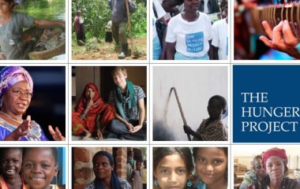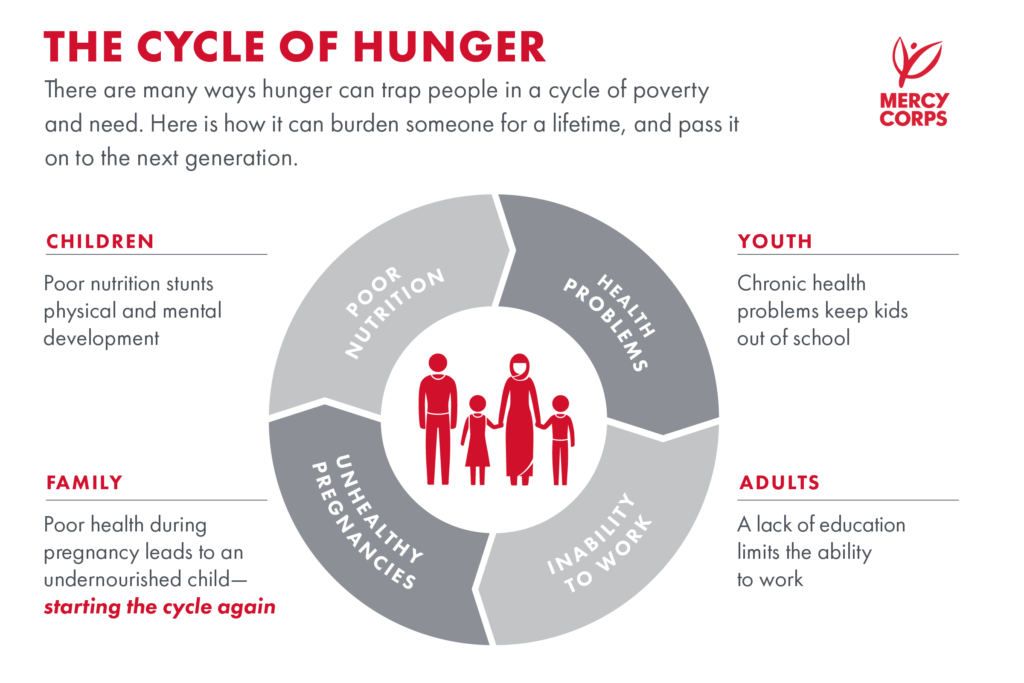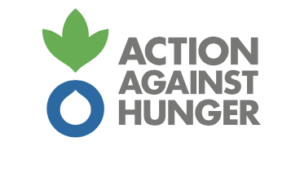HUNGER FACTS
- There is more than enough food produced in the world to feed everyone on the planet.
- 815 million people worldwide go to bed hungry each night.
- Small farmers, herders, and fishermen produce about 70 percent of the global food supply, yet they are especially vulnerable to food insecurity – poverty and hunger are most acute among rural populations.
- Conflict is a major driver of hunger: The UN estimates that 489 million of 815 million undernourished people and 122 million of 155 million stunted children live in countries affected by conflict.
- An estimated 17 million children under the age of five worldwide suffer from severe acute malnutrition, also known as severe wasting, yet only 20 percent of severely malnourished children have access to lifesaving treatment.
- Poor nutrition causes nearly half (45%) of deaths in children under five – 3.1 millionchildren each year. One out of six children — roughly 100 million — in developing countries is underweight. One in four of the world’s children are stunted.
- There are 15.6 million U.S. households suffering from food insecurity – 12.7 percent of all U.S households. 6.1 million U.S. households suffer from severe food insecurity, which means the people who live in them are often hungry. 3.1 million households with children are food insecure at some time each year
- Overall, 5.6 million children under age five died in 2016, nearly 15,000 daily (World Health Organization [WHO], 2016). The risk of a child dying before five years of age is highest in Africa (76.5 per 1000 live births), about 8 times higher than in Europe (9.6 per 1000 live births) (WHO, 2016).
- Approximately 3.1 million children die from undernutrition each year (UNICEF, 2018a). Hunger and undernutrition contribute to more than half of global child deaths, as undernutrition can make children more vulnerable to illness and exacerbate disease (UNICEF, 2018a).
- Children who are poorly nourished suffer up to 160 days of illness each year (Glicken, M.D., 2010). Undernutrition magnifies the effect of every disease including measles and malaria. The estimated proportions of deaths in which undernutrition is an underlying cause are roughly similar for diarrhea (61%), malaria (57%), pneumonia (52%), and measles (45%) (Black, Morris, & Bryce, 2003; Bryce et al., 2005). Malnutrition can also be caused by diseases, such as the diseases that cause diarrhea, by reducing the body’s ability to convert food into usable nutrients (Black, Morris, & Bryce, 2003; Bryce et al., 2005)
- 66 million primary school-age children attend classes hungry across the developing world, 23 million whom live in Africa, which greatly impacts their ability to learn (World Food Programme [WFP], 2012).
The above statistics were gathered from the follwing sources: www.actionagainsthunger.org and worldhunger.org
The Hunger Project
 The Hunger Project is a global, non-profit, strategic organization committed to the sustainable end of world hunger. Our vision is a world where every woman, man and child leads a healthy, fulfilling life of self-reliance and dignity.
The Hunger Project is a global, non-profit, strategic organization committed to the sustainable end of world hunger. Our vision is a world where every woman, man and child leads a healthy, fulfilling life of self-reliance and dignity.
The Hunger Project mission is to end hunger and poverty by pioneering sustainable, grassroots, women-centered strategies and advocating for their widespread adoption in countries throughout the world. The Hunger Project Facts and Statistics:
World Population
- 7.6 billion
World Hunger
– Although the number of undernourished people has dropped by over 20% since 1992 (216 million fewer than in 1990-92) today there are 815 million people who do not have enough to eat. This is more than the 795 million in 2014, although still down from about 900 million in 2000.
– 98% of the world’s undernourished people live in developing countries.
– Where is hunger the worst?
– Asia: 519.6 million
– Sub-Saharan Africa: 223 million
– Latin America and the Caribbean: 42.5 million
Aiming at the very heart of hunger, The Hunger Project is currently committed to work in Bangladesh, Benin, Burkina Faso, Ethiopia, India, Ghana, Malawi, Mexico, Mozambique, Peru, Senegal and Uganda.
Women and Children
– 60 percent of the world’s hungry are women.
– Globally, about one in five births (21%) take place without the assistance of a skilled birth attendant. In 2016, this translated into nearly 31 million unattended births worldwide. Inadequate care during pregnancy and delivery was largely responsible for the annual deaths of an estimated 303,000 mothers and 2.7 million newborns in 2015.
– One out of six infants is born with a low birth weight in developing countries.
– Nearly half of all deaths in children under 5 are attributable to under-nutrition. This translates into the unnecessary loss of about 3 million young lives a year.
– Globally, 155 million children under 5 still suffer from stunting. In 2016, about two out of every four stunted children lived in South Asia and one in three in sub-Saharan Africa.
The Hunger Project firmly believes that empowering women to be key change agents is an essential element to achieving the end of hunger and poverty. Wherever we work, our programs aim to support women and build their capacity.
HIV/AIDS and other Diseases
– 36.7 million people are living with HIV/AIDS.
– 76.1 million [65.2 million–88.0 million] people have become infected with HIV since the start of the epidemic.
– 51% percent of people living with HIV/AIDS are women.
– The vast majority of people living with HIV are located in low- and middle- income countries, with an estimated 25.5 million living in Sub-Saharan Africa.
– New HIV infections among children globally have halved, from 300,000 in 2010 to 160,000 in 2016 (47%).
Launched in 2003, The Hunger Project’s HIV/AIDS and Gender Inequality Campaign works at the grassroots level to provide education about preventative and treatment measures. Read more about our work here.
Poverty
– 767 million people, or 1 in 10 people in the world, live under $1.90 a day, and half of the extreme poor (389 million) live in Sub-Saharan Africa.
– 328 million children are living in extreme poverty.
Rural Hunger Project partners have access to income-generating workshops, empowering their self-reliance. Our Microfinance Program in Africa provides access to credit, adequate training and instilling in our partners the importance of saving.
Agriculture
– 75 percent of the world’s poorest people live in rural areas and depend on agriculture and related activities for their livelihood.
– 50 percent of hungry people are farming families.
In each region in which we work, The Hunger Project provides tools and training to increase farming production at the local level. In Africa, our epicenter partners run community farms where they implement new techniques while producing food for the epicenter food bank.
Water and sanitation
– Some 3 in 10 people worldwide, or 2.1 billion, lack access to safe, readily available water at home
– 6 in 10, or 4.5 billion, lack safely managed sanitation
– Each year, 361,000 children under 5 die due to diarrhea. Poor sanitation and contaminated water are also linked to transmission of diseases such as cholera, dysentery, hepatitis A, and typhoid.
– In countries experiencing conflict or unrest, children are 4 times less likely to use basic water services, and 2 times less likely to use basic sanitation services than children in other countries.
– There are big gaps in service between urban and rural areas. Two out of three people with safely managed drinking water and three out of five people with safely managed sanitation services live in urban areas. Of the 161 million people using untreated surface water (from lakes, rivers or irrigation channels), 150 million live in rural areas.
The Hunger Project works with communities to develop new water resources, ensure clean water and improved sanitation, and implement water conservation techniques.



